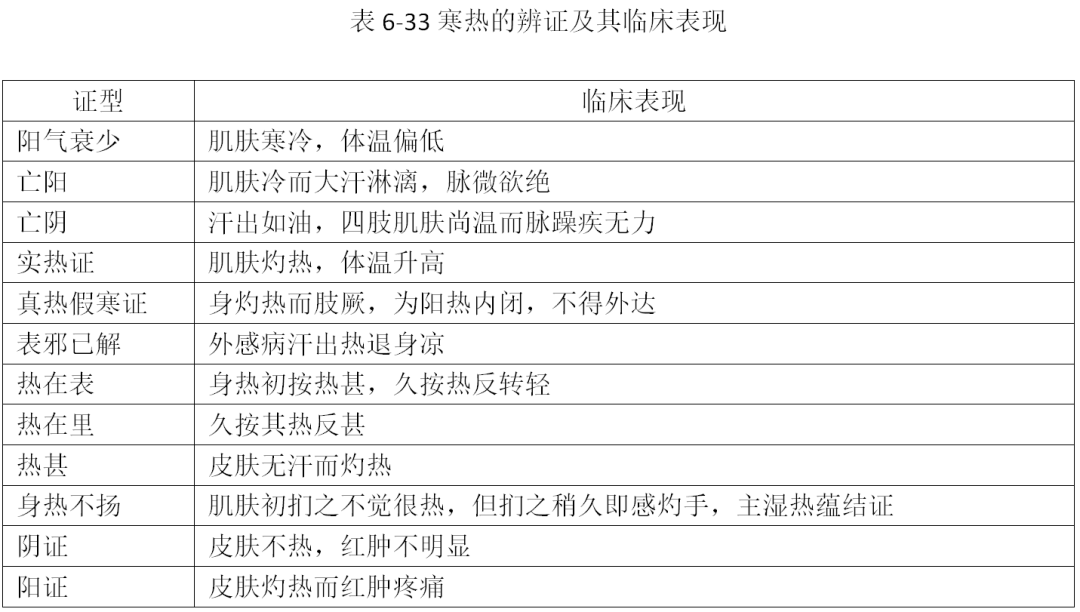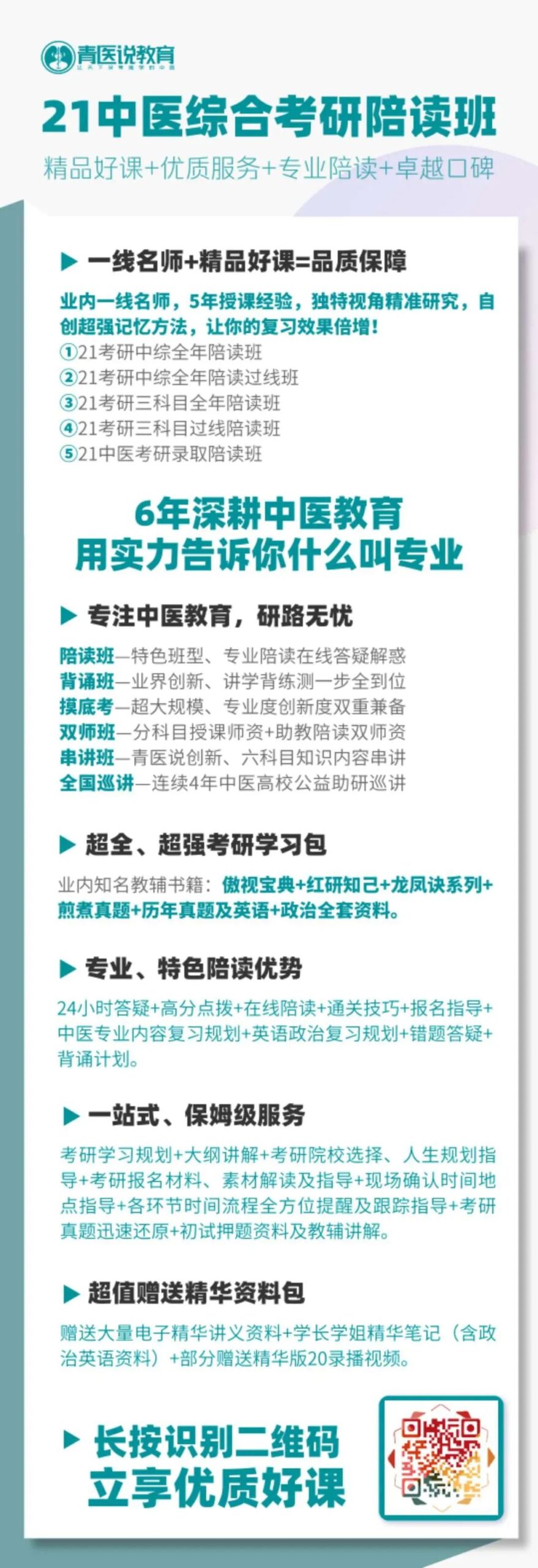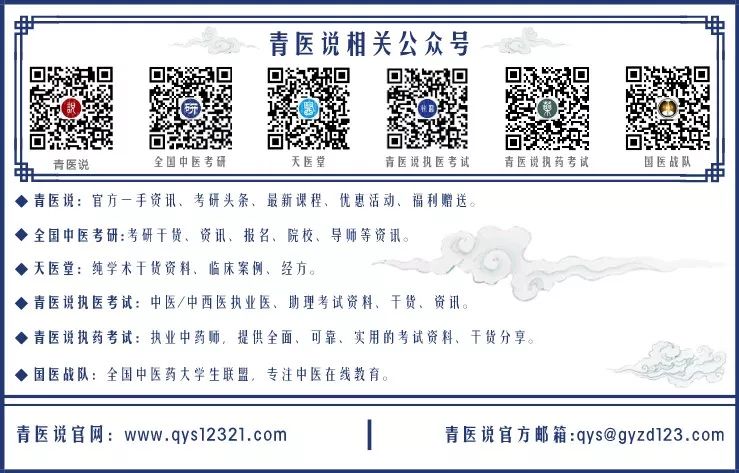

01
Body heat, initially pressing the skin feels hot, but after prolonged pressure, it does not feel hot, is mostly associated with (single choice)
A. Heat in the Wei level
B. Heat in the Qi level
C. Heat in the Ying level
D. Heat in the Blood level
Click on the blank space to see the answer
Answer Analysis: A. Body heat, initially pressing the skin feels hot, but after prolonged pressure, it does not feel hot, indicates that the heat is not severe, belonging to the initial stage of warm heat disease, which is heat in the Wei level (A correct). Heat in the Qi level would show a stronger heat, indicating a vigorous struggle between the evil and the righteous, hence the skin feels burning (B incorrect). Heat in the Ying level and Blood level indicates a more severe stage of warm heat disease, thus the skin feels hot and is worse at night (C and D incorrect).
02
The “movement wanting to cease” without a dead pulse is often seen in (single choice)
A. Deficiency of Zong Qi
B. Leakage of Zong Qi
C. Postpartum women
D. Consumption disease
E. Phlegm-dampness
Click on the blank space to see the answer
Answer Analysis: E. The “movement wanting to cease” is located at the apex of the heart under the left breast, where all pulses converge. Exploring the pulsation of this area can reveal the strength of Zong Qi, the nature of the disease, and the prognosis. Normally, the pulsation here should be felt, moving without tension, slow but not urgent. If it wants to cease without a dead pulse, it is often seen in phlegm-dampness and similar conditions (E correct). Deficiency of Zong Qi would show movement but not prominent (A incorrect). Leakage of Zong Qi would show movement responding to clothing (B incorrect). In pregnant women before and after childbirth or in consumption disease, if the pulsation is felt to be large and bouncing, it indicates a critical condition (C and D incorrect).
03
Which of the following is unrelated to palpation of acupoints (single choice)
A. Localized cord-like structures
B. Presence of nodules
C. Tenderness upon pressure
D. Presence of sensitive reaction points
E. Presence of fluctuation sensation
Click on the blank space to see the answer
Answer Analysis: E. Fluctuation sensation, found when pressing on sores, indicates that pus has formed; or when pressing on the abdomen, indicates accumulation of water (E incorrect, this is the correct answer). Acupoints are where the Qi of the organs and meridians is transmitted, reflecting internal organ changes on the body surface. Pressing certain specific acupoints can reveal pathological responses including obvious tenderness (C correct), nodules (B correct), cord-like structures (A correct), and other sensitive reactions (D correct).
04
In lung diseases, which acupoint shows tenderness upon pressure (single choice)
A. Zu San Li (Stomach 36)
B. Zhong Fu (Lung 1)
C. Fei Shu (Lung Back Shu)
D. Shang Ju Xu (Stomach 37)
E. Qi Men (Liver 14)
Click on the blank space to see the answer
Answer Analysis: B. Acupoints are where the Qi of the organs and meridians is transmitted, reflecting internal organ changes on the body surface. Pressing certain specific acupoints can indicate certain internal diseases based on the tenderness, nodules, etc. In lung diseases, tenderness can be felt at the Zhong Fu acupoint (B correct). Tenderness at Zu San Li is seen in stomach diseases (A incorrect). Nodules at Fei Shu can indicate lung diseases (C incorrect). Tenderness at Shang Ju Xu can be seen in intestinal abscess (D incorrect). Tenderness at Qi Men can indicate liver diseases (E incorrect).
05
In intestinal abscess, which acupoint shows tenderness upon pressure (single choice)
A. Zu San Li (Stomach 36)
B. Zhong Fu (Lung 1)
C. Fei Shu (Lung Back Shu)
D. Shang Ju Xu (Stomach 37)
E. Qi Men (Liver 14)
Click on the blank space to see the answer
Answer Analysis: D. Acupoints are where the Qi of the organs and meridians is transmitted, reflecting internal organ changes on the body surface. Pressing certain specific acupoints can indicate certain internal diseases based on the tenderness, nodules, etc. Tenderness at Shang Ju Xu can be seen in intestinal abscess (D correct). Tenderness at Zhong Fu is seen in lung diseases (B incorrect). Tenderness at Zu San Li is seen in stomach diseases (A incorrect). Nodules at Fei Shu can indicate lung diseases (C incorrect). Tenderness at Qi Men can indicate liver diseases (E incorrect).
Traditional Chinese Medicine DiagnosisChapter Six Palpation (Part Six)(Number of questions in national exams over the years: 6 questions) Three, Palpation of the Skin Key Point One: The content and clinical significance of diagnosing cold and heat Key Point AnalysisThe focus of this key point is on the clinical characteristics of Yang deficiency, Yin deficiency, body heat not rising, and true heat-false cold syndrome. Key Point Two: The content and clinical significance of diagnosing moistness and dryness, smoothness and roughness 1. Generally, dry skin indicates no sweating.2. Moist skin indicates sweating has occurred.3. Shrivelled skin indicates insufficient body fluids.4. Smooth skin indicates abundant Qi and blood.5. Rough skin indicates deficiency of Qi and blood.6. New disease skin is often smooth and shiny, indicating that Qi and blood have not been harmed.7. Long-term illness skin is often rough, indicating deficiency of body fluids or both Qi and blood.8. Skin with scales is often due to blood deficiency or stasis of blood. Key Point AnalysisThis key point requires memorization of the skin manifestations of both Qi and blood deficiency and blood deficiency leading to loss of nourishment. Key Point Three: The content and clinical significance of diagnosing pain 1. Generally, soft skin that reduces pain upon pressure indicates a deficiency syndrome.2. Hard pain that resists pressure indicates a excess syndrome.3. Pain upon light pressure indicates a superficial disease.4. Pain upon heavy pressure indicates a deep disease. Key Point AnalysisThis key point is generally familiar. Key Point Four: The content and clinical significance of diagnosing swelling 1. If pressing causes a dent that does not immediately return, it indicates edema.2. If pressing causes a dent that returns immediately, it indicates Qi edema. Key Point AnalysisThis key point is generally familiar. Key Point Five: The content and clinical significance of diagnosing sores and ulcers
Key Point AnalysisThe focus of this key point is on the clinical characteristics of Yang deficiency, Yin deficiency, body heat not rising, and true heat-false cold syndrome. Key Point Two: The content and clinical significance of diagnosing moistness and dryness, smoothness and roughness 1. Generally, dry skin indicates no sweating.2. Moist skin indicates sweating has occurred.3. Shrivelled skin indicates insufficient body fluids.4. Smooth skin indicates abundant Qi and blood.5. Rough skin indicates deficiency of Qi and blood.6. New disease skin is often smooth and shiny, indicating that Qi and blood have not been harmed.7. Long-term illness skin is often rough, indicating deficiency of body fluids or both Qi and blood.8. Skin with scales is often due to blood deficiency or stasis of blood. Key Point AnalysisThis key point requires memorization of the skin manifestations of both Qi and blood deficiency and blood deficiency leading to loss of nourishment. Key Point Three: The content and clinical significance of diagnosing pain 1. Generally, soft skin that reduces pain upon pressure indicates a deficiency syndrome.2. Hard pain that resists pressure indicates a excess syndrome.3. Pain upon light pressure indicates a superficial disease.4. Pain upon heavy pressure indicates a deep disease. Key Point AnalysisThis key point is generally familiar. Key Point Four: The content and clinical significance of diagnosing swelling 1. If pressing causes a dent that does not immediately return, it indicates edema.2. If pressing causes a dent that returns immediately, it indicates Qi edema. Key Point AnalysisThis key point is generally familiar. Key Point Five: The content and clinical significance of diagnosing sores and ulcers Key Point AnalysisThis key point is generally familiar. Key Point Six: The content and clinical significance of diagnosing the skin of the wrist The skin of the wrist: the area between the inner side of the elbow and the transverse line of the palm. 1. In healthy individuals, the skin of the wrist is warm, smooth, and elastic.2. If the skin of the wrist is very hot, it often indicates a heat syndrome.3. If the skin of the wrist is cool, it often indicates diarrhea or deficiency of Qi.4. If pressing the skin of the wrist causes a deep dent that does not return, it often indicates wind-water.5. If the skin of the wrist is rough like the scales of a dried fish, it often indicates deficiency of essence and blood, or stasis of blood, leading to malnourishment of the skin; it may also indicate deficiency of Spleen Yang, leading to phlegm-dampness. Key Point AnalysisThis key point is relatively simple and can be memorized through understanding. Focus on remembering the content of points 4 and 5, as they may be of exam value. Four, Palpation of the Hands and FeetKey Point: The content and clinical significance of cold and heat in the hands and feet 1. Cold syndrome (1) If Yang deficiency is present, the limbs may still feel warm, indicating that Yang Qi is still present. (2) If the limbs are cold, it often indicates a severe condition. (3) If both hands and feet are cold, it indicates Yang deficiency and cold excess, belonging to a cold syndrome. 2. Heat syndrome (1) If both hands and feet are hot, it often indicates Yang excess and heat excess, belonging to a heat syndrome. (2) In heat syndrome, if the hands and feet are hot, it is a normal response; if the hands and feet are cold, it is a reverse response, often due to excessive heat causing Yang Qi to be trapped internally, indicating deep heat and deep cold, which should be carefully distinguished. (3) Comparing heat in the palms and forehead, if the forehead is hotter than the palms, it indicates exterior heat; if the palms are hotter than the forehead, it indicates interior heat. Comparing the palms and backs of the hands, if the backs of the hands are hotter, it often indicates exterior heat, while if the palms are hotter, it often indicates internal heat. Key Point AnalysisThe focus of this key point is on the relationship between different manifestations of cold and heat and their corresponding main syndromes, particularly noting the significance of “deep heat and deep cold” which may be examined. Five、Palpation of Acupoints Key Point: The physiological and pathological responses of acupoints (content and clinical significance) 1. Physiological responses of acupointsNormal acupoints should feel a sense of soreness and distension upon pressure, without tenderness, nodules, cord-like structures, or abnormal sensations and responses. 2. Pathological responses of acupoints: There may be obvious tenderness, nodules, cord-like structures, or other sensitive reactions. (1) For example, if nodules are felt at the Fei Shu acupoint, or if there is obvious tenderness at the Zhong Fu acupoint, it indicates a lung disease response. (2) If significant tenderness is felt 1-2 inches below the Shang Ju Xu acupoint, it indicates intestinal pain. (3) Patients with liver diseases often have tenderness at the Gan Shu or Qi Men acupoints. (4) Commonly used acupoints for diagnosing organ diseases include:
Key Point AnalysisThis key point is generally familiar. Key Point Six: The content and clinical significance of diagnosing the skin of the wrist The skin of the wrist: the area between the inner side of the elbow and the transverse line of the palm. 1. In healthy individuals, the skin of the wrist is warm, smooth, and elastic.2. If the skin of the wrist is very hot, it often indicates a heat syndrome.3. If the skin of the wrist is cool, it often indicates diarrhea or deficiency of Qi.4. If pressing the skin of the wrist causes a deep dent that does not return, it often indicates wind-water.5. If the skin of the wrist is rough like the scales of a dried fish, it often indicates deficiency of essence and blood, or stasis of blood, leading to malnourishment of the skin; it may also indicate deficiency of Spleen Yang, leading to phlegm-dampness. Key Point AnalysisThis key point is relatively simple and can be memorized through understanding. Focus on remembering the content of points 4 and 5, as they may be of exam value. Four, Palpation of the Hands and FeetKey Point: The content and clinical significance of cold and heat in the hands and feet 1. Cold syndrome (1) If Yang deficiency is present, the limbs may still feel warm, indicating that Yang Qi is still present. (2) If the limbs are cold, it often indicates a severe condition. (3) If both hands and feet are cold, it indicates Yang deficiency and cold excess, belonging to a cold syndrome. 2. Heat syndrome (1) If both hands and feet are hot, it often indicates Yang excess and heat excess, belonging to a heat syndrome. (2) In heat syndrome, if the hands and feet are hot, it is a normal response; if the hands and feet are cold, it is a reverse response, often due to excessive heat causing Yang Qi to be trapped internally, indicating deep heat and deep cold, which should be carefully distinguished. (3) Comparing heat in the palms and forehead, if the forehead is hotter than the palms, it indicates exterior heat; if the palms are hotter than the forehead, it indicates interior heat. Comparing the palms and backs of the hands, if the backs of the hands are hotter, it often indicates exterior heat, while if the palms are hotter, it often indicates internal heat. Key Point AnalysisThe focus of this key point is on the relationship between different manifestations of cold and heat and their corresponding main syndromes, particularly noting the significance of “deep heat and deep cold” which may be examined. Five、Palpation of Acupoints Key Point: The physiological and pathological responses of acupoints (content and clinical significance) 1. Physiological responses of acupointsNormal acupoints should feel a sense of soreness and distension upon pressure, without tenderness, nodules, cord-like structures, or abnormal sensations and responses. 2. Pathological responses of acupoints: There may be obvious tenderness, nodules, cord-like structures, or other sensitive reactions. (1) For example, if nodules are felt at the Fei Shu acupoint, or if there is obvious tenderness at the Zhong Fu acupoint, it indicates a lung disease response. (2) If significant tenderness is felt 1-2 inches below the Shang Ju Xu acupoint, it indicates intestinal pain. (3) Patients with liver diseases often have tenderness at the Gan Shu or Qi Men acupoints. (4) Commonly used acupoints for diagnosing organ diseases include: Key Point AnalysisThis key point is the focus of this chapter, concentrating on the pathological responses of acupoints, such as tenderness points, cord-like structures, etc. Familiarity with commonly used acupoints for diagnosing organ diseases is sufficient.
Key Point AnalysisThis key point is the focus of this chapter, concentrating on the pathological responses of acupoints, such as tenderness points, cord-like structures, etc. Familiarity with commonly used acupoints for diagnosing organ diseases is sufficient.
Qing Yi Says

Dedicated to Online Education in Traditional Chinese Medicine
■ ■ ■ ■

Editor: Citric Acid




